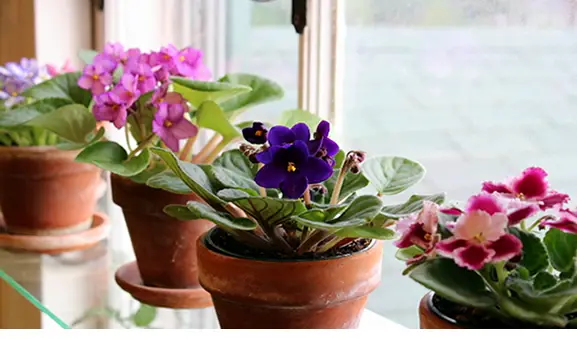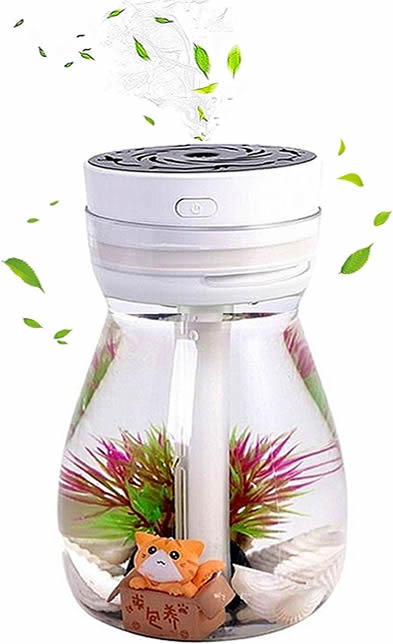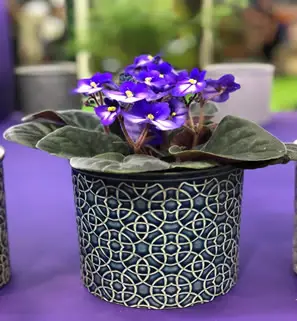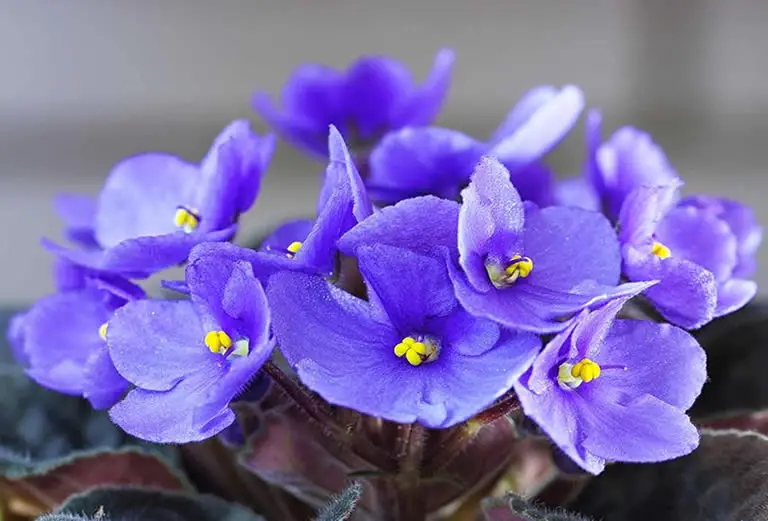In this article I outline the optimal humidity levels needed for growing african violets along with the ideal conditions required for this plant. I also cover the recommended soil moisture levels.
Table of Contents
Arican Violets like the type of humidity you don’t!
African violets grow naturally in the high mountainous regions that are common in the tropical areas of Africa.
They are tropical plants. So, does this mean they like humidity?
African violets like humidity. In their natural environment african violets experience humidity levels between 70% – 80%.
However, african violets are mostly grown as houseplants and 80% humidity can be uncomfortable for humans, so it is best to keep humidity levels between 50% – 60% .
The african violet is a topical plant.
In the tropical mountainous regions of Africa, such as in Tanzania, which is the native habitat for african violets, the temperature is warm and humidity levels are high.
In these tropical climates humidity levels can reach as high as 80%.
So african violets will naturally thrive in humid warm environments.
Unfortunately though, for Americans, keeping your home humidity levels at 80% is simply not an option.

Although not everyone’s the same, it is generally accepted that when humidity levels approach and exceed about 65%, the environment becomes uncomfortable for human beings.
This discomfort is worsened the higher the temperatures are.
Being a tropical plant african violets not only like high humidity levels but they also like warmth.
Their natural habitat experiences temperatures ranging from 70°F – 80°F during the day and 65°F – 70°F at night.
Unfortunately this means that it would be uncomfortable for a houseplant owner to try to replicate the native conditions of an african violet in their home. This plant likes the type of warm humid conditions that are uncomfortable for humans.
So, how can you ensure your african violets are given the correct amount of humidity and warmth without having to compromise your comfort or keep your plants in a greenhouse?
How much humidity African Violets really need
As I covered above african violets experience very high humidity levels in their native habitat, but this type of humidity is difficult to replicate when growing houseplants.
African violets need humidity levels of at least 50%.
In their native habitat they experience humidity levels between 70% and 80%.
Ideally, african violet houseplants should have humidity levels of between 50% – 80%.
With the average home having a humidity level of between 30% – 50% you will likely need to take steps to ensure your african violet houseplant has the right humidity.
You can do this is in a number of ways. I personally use a cool mist humidifier. I also use specific pots.
If you grow your african violet plant in a standard plant pot, whether that be terracotta, plastic, glazed or something else, you can help keep humidity levels up by placing a saucer or tray underneath the pot.
By putting small pebbles in the tray along with a small quantity of water, humidity levels will be kept high.

As the water evaporates from the tray it automatically increases the humidity levels of the local environment around the plant.
A word of caution though: do not put too much water into the tray or saucer as african violets do not like to sit in water.
Although you can root and propagate african violets in water leaving an african violet sitting in water will lead to a number of problems from dropping leaves to rot root.
What about misting the plant to help increase humidity levels, is that an acceptable course of action?
The harsh truth about misting African Violets
African violets need higher humidity levels than those that are comfortable for humans.
So, it stands to reason that you need to take some action steps to raise the humidity levels directly around your plant.
However, you need to do this without increasing the overall humidity levels in your home. One very popular method for doing this, is misting the plant with water.
Although this is perfectly fine for many common houseplants, it is not a good idea to mist your african violets.
You can mist african violets but I do not recommend it.
African violets are best watered from the bottom as the leaves do not react well to being watered.
Misting an african violet to help improve humidity levels is ok to do occasionally but prolonged exposure to water will cause leaf damage.
It is best to use the other methods mentioned, for increasing humidity.
If you read our african violet leaves guide you will quickly learn why it is a bad idea to wet the foliage of your african violet.
Because african violet leaves are best left dry I discourage people from misting their plants at all.
Some gardening websites will tell you that you can mist your african violets every day to help increase humidity levels. Don’t do that!
This erroneous advice just me shows that is offered by someone who has never cultivated african violets or, it’s being given by someone who is confusing african violets with violets.
African violets are not violets they are a completely different plant!
Occasional misting of an african violet will not do much harm but if your regular care routine includes misting the plant then you may find that leaf damage occurs quite quickly.
In truth, misting an african violet should only be used as a last resort.
There are other steps you can take to increase the humidity level directly around your african violet houseplant I really do not see the need to run the risk of damaging the plant from misting it.
African Violets don’t need that much water
With an environment that offers high humidity levels the african violets don’t need to be watered as much as other common houseplants.
African violets like to dry out. Soil should be allowed to dry out before watering.
Although african violets like moist soil after they have been watered, they do not like soaked soil.
Allowing the top layer of soil to dry out before watering the plant ensures moisture levels in the soil are at optimal levels.

The easiest way to ensure your african violet soil has the correct moisture levels is to use a self-watering pot or container.
Just keep in mind (as I covered in this article) that african violets do not like to be root bound. because the roots grow outward rather than downward, wider pots that are shallower than normal, like these, tend to work best.
How to replicate the conditions that African Violets like
So what are the ideal conditions for african violets in their native habitat and what conditions do indoor african violet houseplants like?
African violets in their natural habitat like humidity levels between 70% – 80% and temperatures between 70°F – 80°F during the day and 65°F – 70°F at night.
An african violet houseplant requires a humidity level of about 50% and temperatures about 70°F.
African violets need indirect sunlight but can grow in dim light.
Luckily the average home is kept at a temperature of around 70°F which means you do not have to take any additional steps to ensure your african violet is warm enough.
Humidity levels are a different story however.
An average home can have humidity levels that range anywhere between 30% to 50%.
This means if you live in a home that is at the lower end of the humidity spectrum then your african violet will not be in an environment that is optimal for healthy growth.
Luckily though there are a few things that you can do to rectify this situation.
Growing african violets placed in pots specifically designed for plants that are watered from the bottom is the easiest way to maintain optimal humidity levels around your plant.
If you use a standard plant pot then placing a saucer or tray underneath the pot and filling it with pebbles and a little water can help to increase the humidity levels directly around the plant.
Be sure not to put too much water into the tray as african violets do not like to sit in water.
See our african violet watering guide.

